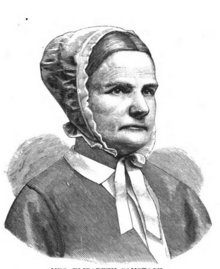Elizabeth Rous Comstock
| Elizabeth Rous Comstock | |
|---|---|
 | |
| Born |
Elizabeth Leslie Rous October 30, 1815 Maidenhead, Berkshire England |
| Died |
August 3, 1891 Union Springs, New York |
Elizabeth Leslie Comstock (October 30, 1815- August 3, 1891) was a Quaker minister and social reformer, abolitionist and worker for social welfare who helped the Society of Friends adjust to the urban-industrial age. Comstock was a very active spokesperson who educated people about those stricken by illness in places such as hospitals and prison camps. In the time of the American Civil War, Comstock worked to relieve people who had recently been freed. Comstock was instrumental in the Underground Railroad, leading a very active station in Rollin, Michigan.
Early life
Comstock was born on October 30, 1815 to William and Mary Rous in Berkshire, England. Comstock was the oldest of nine children.[1] Seven of her siblings were boys and one girl. Comstock attended Quaker schools in Islington and at Croydon.[2][1][3][4][5]
Early career
After completing school, Comstock returned to Corydon as a teacher, in 1839.[2] Comstock later taught Friends school at Ackworth, from 1842 to 1848.[2] After her marriage to Leslie Wright, they ran a shop together in Bakewell, Derbyshire for three years.
Activism

In 1854, the Comstock immigrated to Canada, and became a Quaker minister.[6] Four years later, Comstock moved to Michigan, and became active in the abolitionist movement. Comstock became the leader of Quaker communities of southeastern Michigan.[2] Comstock ran the Rollin station of the Underground Railroad.[7] During the Civil War, Comstock ministered in hospitals and prison camps. In advocating for prison reform Comstock gave preaching tours of prisons, and spoke on behalf of humane treatment of inmates and pleaded the cause of prisoners of whose innocence Comstock believed in.[2]
After the war, Comstock continued to advocated for prison reform, temperance, peace, women's rights, home-mission welfare work and how to adapt to urbanization.[4][8] In 1879, Comstock toured the country raising funds, for the "Exodusters," the numerous black emigrants from the South to Kansas.[2] Comstock was then the secretary of the Kansas Freedmen's Relief Association (1879-1881).[2]
Personal life
In 1848, Comstock married Leslie Wright in Bakewell, Derbyshire until his death in 1851.[2] They had one daughter.[2] After Wright's death, Comstock, their daughter and one of Comstock's sisters moved to Rollin Michigan. In 1858 Comstock remarried to John T. Comstock, until his death in 1884.
References
- 1 2 "Letter from Elizabeth Leslie Rous Comstock, February 22, 1886". North American Women's Letters and Diaries. Alexander Street Press. Retrieved November 8, 2016.
- 1 2 3 4 5 6 7 8 9 Hamm, Thomas (February 2000). "Elizabeth Leslie Comstock". American National Biography. Oxford University Press. Retrieved November 8, 2016.
- ↑ Comstock, Elizabeth. "Life and Letters". gdc.galegroup.com. Headley Brothers.
- 1 2 "Elizabeth Leslie Rous Comstock". Britannica Academic. Britannica. September 19, 2016. Retrieved November 8, 2016.
- ↑ "Elizabeth Leslie Rous Comstock". Encyclopædia Britannica. Britannica. October 24, 2003. Retrieved November 8, 2016.
- ↑ Spencer, Carole (Spring 1991). "Evangelism, Feminism and Social Reform: The Quaker Woman Minister and the Holiness Revival". JSTOR 41947185.
- ↑ "Woman and Temperance: Or, The Work and Workers of the Woman's Christian Temperance Union". Retrieved November 17, 2016.
- ↑ "Memorial of Elizabeth L. Comstock". ProQuest. Friend's Intelligencer. Retrieved November 8, 2016.
External links
| Wikimedia Commons has media related to Elizabeth Rous Comstock. |